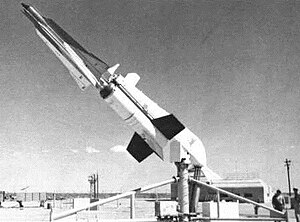| RIM-50 Typhon LR RIM-55 Typhon MR | |
|---|---|
 Typhon LR on launcher | |
| Type | Long range surface-to-air missile |
| Place of origin | United States |
| Service history | |
| Used by | United States Navy |
| Production history | |
| Manufacturer | Bendix Corporation |
| Specifications (Typhon LR) | |
| Mass | 1,700 lb (770 kg) without booster 3,620 lb (1,640 kg) with booster |
| Length | 15 ft 6 in (4.72 m) without booster 27 ft 7 in (8.41 m) with booster |
| Diameter | 16 in (410 mm) missile 18.5 in (470 mm) booster |
| Wingspan | 3 ft 4 in (1.02 m) missile 5 ft 2 in (1.57 m) booster |
| Warhead | 150 lb (68 kg) high explosive or W60 nuclear |
Detonation mechanism | Proximity fuse |
| Engine | Booster, solid-propellant rocket Sustainer, Bendix ramjet |
Operational range | 200 nmi (230 mi; 370 km) |
| Flight ceiling | 95,000 ft (29,000 m) |
| Maximum speed | Mach 4.0 |
Guidance system | Track-via-missile |
| References | Parsch 2001a[1] |
Typhon was a missile system developed by the United States Navy in the late 1950s, intended to serve as an integrated air-defense system for Navy fleets. Consisting of the SAM-N-8 Typhon LR, later designated RIM-50A, and the SAM-N-9 Typhon MR, later RIM-55A, paired with the AN/SPG-59 radar system, the cost of the Typhon system led to it being cancelled in favor of the Standard Missile program.